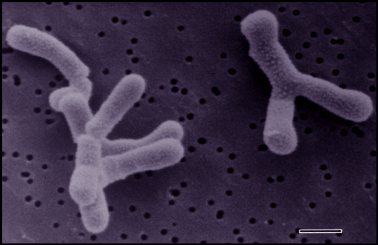Bifidobacterium
Материал из Поле цифровой дидактики
Версия от 15:19, 23 сентября 2022; Анастасия Сергеевна Цибина (обсуждение | вклад)
| Описание микроба | Бифидобактерии (лат. Bifidobacterium: bifidus — разделённый надвое и bacteria — бактерия) — род грамположительных анаэробных бактерий.
Бифидобактерии, называемые пробиотиками, являются естественной частью бактериальной флоры в организме человека и имеют симбиотические отношения бактерии-хозяин с людьми. B. longum способствует хорошему пищеварению, укрепляет иммунную систему и вырабатывает молочную и уксусную кислоты, которые контролируют рН кишечника. Эти бактерии также подавляют рост Candida albicans, кишечной палочки и других бактерий, которые обладают более патогенными свойствами, чем бифидобактерии. |
|---|---|
| Верхний таксон | Bacteria; Actinobacteria; Actinobacteria (class); Actinobacteridae; Bifidobacteriales; Bifidobacteriaceae |
| Species - виды | B. angulatum; B. animalis; B. asteroides; B. bifidum; B. boum; B. breve; B. catenulatum; B. choerinum; B. coryneforme; B. cuniculi; B. dentium; B. gallicum; B. gallinarum; B indicum; B. longum; B. magnum; B. merycicum; B. minimum; B. pseudocatenulatum; B. pseudolongum; B. psychraerophilum; B. pullorum; B. ruminantium; B. saeculare; B. scardovii; B. simiae; B. subtile; B. thermacidophilum; B. thermophilum; B. urinalis; B. sp. |
| Genome Structure= структура генома | The circular chromosome of Bifidobacterium longum has a genome approximately 2,260,000 bp in length with a 60% G-C content. More research is being done on sequencing other species of Bifidobacterium, especially to understand its probiotic qualities. |
| Cell Structure - клеточная структура | Bifidobacterium is a Gram-positive, anaerobic, branched rod-shaped bacterium. In the intestines, they ferment sugars to produce lactic acid. The B. longum genome codes for many proteins specialized for the catabolism of oligosaccharides. This bacterium also is able to use so-called "nondigestible" plant polymers or host-derived glycoproteins and glycoconjugates; it is thought that Bifidobacterium's ability to compete with other gastrointestinal bacteria and occupy a large percentage in the bacterial flora of the gastrointestinal region might be partly due to the large variety of molecules that it is able to use for energy |
| Ecology= экология обитания | While Bifidobacterium infantis, B. brevi, and B. longum are the largest group of bacteria in the intestine of infants, Bifidobacteria are said to be only the 3rd or 4th largest group in adults (and comprise only 3-6% of adult fecal flora). The number of Bifidobacteria actually decline in the human body with age. In infants who are breast-fed, Bifidobacteria constitute about 90% of their intestinal bacteria; however, this number is lower in bottle-fed infants. When breast-fed infants' diets are changed to cows milk and solid food, Bifidobacteria are joined by rising numbers of other bacteria found in the human body such as Bacteroides and Streptococci lactobacilli. The lower number of Bifidobacteria in formula-fed babies might account for a higher risk of diarrhea and allergies that is usually associated with babies who aren't breast-fed; in addition, because Bifidobacteria produces lactic acid instead of gas (like E. coli), infants and people in general with more Bifidobacteria than other bacteria will have less gas and digestive problems. There is also a significant difference in the incidence of antibiotic-associated diarrhea in the children receiving probiotic-supplemented (inriched with Bifidobacterium) formula (16%) than nonsupplemented formula (31%). |
https://atlas.ru/blog/bifidobaktierii-rol-v-zdorovie-mikrobioty-i-vsiegho-orghanizma/ https://microbewiki.kenyon.edu/index.php/Bifidobacterium

